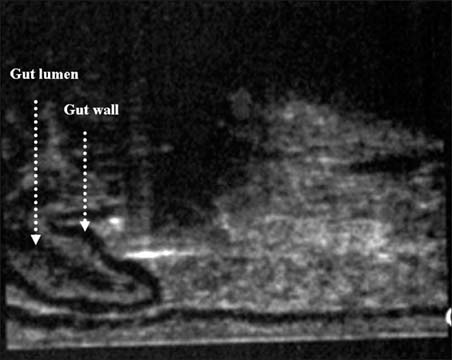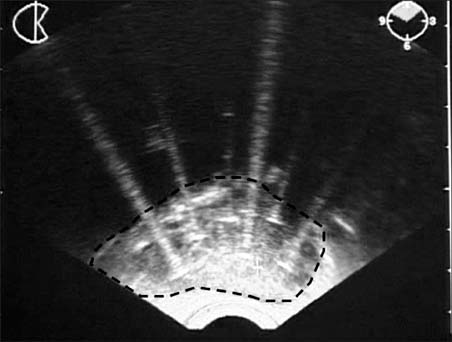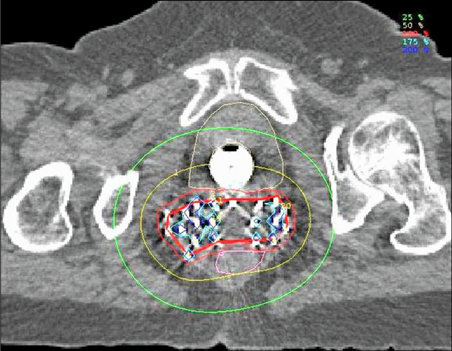J Gynecol Oncol.
2010 Mar;21(1):12-17. 10.3802/jgo.2010.21.1.12.
Use of transrectal ultrasound for high dose rate interstitial brachytherapy for patients of carcinoma of uterine cervix
- Affiliations
-
- 1Department of Radiation Oncology, All India Institute of Medical Sciences, New Delhi, India. sharmadn@hotmail.com
- 2Department of Radiodiagnosis, All India Institute of Medical Sciences, New Delhi, India.
- 3Department of Gynecology and Obstetrics, All India Institute of Medical Sciences, New Delhi, India.
- KMID: 2173503
- DOI: http://doi.org/10.3802/jgo.2010.21.1.12
Abstract
OBJECTIVE
Transrectal ultrasound (TRUS) has been widely used for guiding prostate implants, but not much for interstitial brachytherapy (IBT) of cervix cancer. The aim of our study is to report our experience with TRUS guided high dose rate (HDR) IBT in patients with carcinoma of uterine cervix. METHODS: During the year 2005-2006, 25 patients of cervical cancer not suitable for intracavitary radiotherapy (ICRT), were enrolled in this prospective study. We used B-K Medical USG machine (Falcon 2101) equipped with a TRUS probe (8658) having a transducer of 7.5 MHz for IBT. Post procedure, a CT scan was done for verification of needle position and treatment planning. Two weekly sessions of HDR IBT of 8-10 Gy each were given after pelvic external beam radiation therapy. RESULTS: A total of 40 IBT procedures were performed in 25 patients. Average duration of implant procedure was 50 minutes. There was no uterine perforation in any of 11 patients in whom central tandem was used. CT scan did not show needle perforation of bladder/rectum in any of the patients. During perioperative period, only 1 procedure (2.5%) was associated with hematuria which stopped within 6 hours. Severe late toxicity was observed in 3 (12%) patients. Overall pelvic control rate was 64%. CONCLUSION: Our experience suggests that TRUS is a practical and effective imaging device for guiding the IBT procedure of cervical cancer patients. It helps in accurate placements of needles thus avoiding the injury to normal pelvic structures.
MeSH Terms
Figure
Reference
-
1. Perez CA, Kavanagh BD. Halperin EC, Parez CA, Brady LW, editors. Uterine cervix. Perez and Brady's principles and practice of radiation oncology. 2008. 5th ed. Philadelphia: Lippincott Williams & Wilkins;1532–1609.2. Erickson B, Gillin MT. Nag S, editor. Interstitial implantation of gynecological malignancies. Principles and practice of brachytherapy. 1997. Armonk: Futura Publishing Company;515–552.3. Martinez A, Herstein P, Portnuff J. Interstitial therapy of perineal and gynecological malignancies. Int J Radiat Oncol Biol Phys. 1983. 9:409–416.4. Martinez A, Cox RS, Edmundson GK. A multiple-site perineal applicator (MUPIT) for treatment of prostatic, anorectal, and gynecologic malignancies. Int J Radiat Oncol Biol Phys. 1984. 10:297–305.5. Syed AMN, Puthawala AA, Neblett D, Disaia PJ, Berman ML, Rettennaier M, et al. Transperineal interstitial-intracavitary "Syed-Neblett" applicator in the treatment of carcinoma of the uterine cervix. Endocurie Hypertherm Oncol. 1986. 2:1–13.6. Erickson B, Albano K, Gillin M. CT-guided interstitial implantation of gynecologic malignancies. Int J Radiat Oncol Biol Phys. 1996. 36:699–709.7. Demanes DJ, Rodriguez RR, Bendre DD, Ewing TL. High dose rate transperineal interstitial brachytherapy for cervical cancer: high pelvic control and low complication rates. Int J Radiat Oncol Biol Phys. 1999. 45:105–112.8. Beriwal S, Bhatnagar A, Heron DE, Selvaraj R, Mogus R, Kim H, et al. High-dose-rate interstitial brachytherapy for gynecologic malignancies. Brachytherapy. 2006. 5:218–222.9. Nag S, Martinez-Monge R, Ellis R, Lewandowski G, Vacarello L, Boutselis JG, et al. The use of fluoroscopy to guide needle placement in interstitial gynecological brachytherapy. Int J Radiat Oncol Biol Phys. 1998. 40:415–420.10. Erickson B, Foley WD, Gillin M, Albano K, Wilson JF. Ultrasound-guided transperineal interstitial implantation of pelvic malignancies: description of the technique. Endocurie Hypertherm Oncol. 1995. 11:107–113.11. Corn BW, Lanciano RM, Rosenblum N, Schnall M, King S, Epperson R. Improved treatment planning for the Syed-Neblett template using endorectal-coil magnetic resonance and intraoperative (laparotomy/laparoscopy) guidance: a new integrated technique for hysterectomized women with vaginal tumors. Gynecol Oncol. 1995. 56:255–261.12. Viswanathan A, Cormack R, Holloway CL, Tanaka C, O'Farrell D, Devlin PM, et al. Magnetic resonance-guided interstitial therapy for vaginal recurrence of endometrial cancer. Int J Radiat Oncol Biol Phys. 2006. 66:91–99.13. Recio FO, Piver MS, Hempling RE, Eltabbakh GH, Hahn S. Laparoscopic-assisted application of interstitial brachytherapy for locally advanced cervical carcinoma: results of a pilot study. Int J Radiat Oncol Biol Phys. 1998. 40:411–414.14. Monk BJ, Walker JL, Tewari K, Ramsinghani NS, Nisar Syed AM, DiSaia PJ. Open interstitial brachytherapy for the treatment of local-regional recurrences of uterine corpus and cervix cancer after primary surgery. Gynecol Oncol. 1994. 52:222–228.15. Fleischer AC, Burnett LS, Murray MJ, Jones HW 3rd. Intraoperative guidance for intrauterine procedures with transrectal sonography. Radiology. 1990. 176:576–577.16. Holm HH, Juul N, Pedersen JF, Hansen H, Stroyer I. Transperineal 125iodine seed implantation in prostatic cancer guided by transrectal ultrasonography. J Urol. 1983. 130:283–286.17. Kini VR, Edmundson GK, Vicini FA, Jaffray DA, Gustafson G, Martinez AA. Use of three-dimensional radiation therapy planning tools and intraoperative ultrasound to evaluate high dose rate prostate brachytherapy implants. Int J Radiat Oncol Biol Phys. 1999. 43:571–578.18. Stock RG, Chan K, Terk M, Dewyngaert JK, Stone NN, Dottino P. A new technique for performing Syed-Neblett template interstitial implants for gynecologic malignancies using transrectal-ultrasound guidance. Int J Radiat Oncol Biol Phys. 1997. 37:819–825.19. Haie-Meder C, Potter R, Van Limbergen E, Briot E, De Brabandere M, Dimopoulos J, et al. Recommendations from Gynaecological (GYN) GEC-ESTRO Working Group (I): concepts and terms in 3D image based 3D treatment planning in cervix cancer brachytherapy with emphasis on MRI assessment of GTV and CTV. Radiother Oncol. 2005. 74:235–245.20. Potter R, Haie-Meder C, Van Limbergen E, Barillot I, De Brabandere M, Dimopoulos J, et al. Recommendations from Gynaecological (GYN) GEC ESTRO Working Group (II): concepts and terms in 3D image-based treatment planning in cervix cancer brachytherapy-3D dose volume parameters and aspects of 3D image-based anatomy, radiation physics, radiobiology. Radiother Oncol. 2006. 78:67–77.21. Brascho DJ, Kim RY, Wilson EE. Use of ultrasonography in planning intracavitary radiotherapy of endometrial carcinoma. Radiology. 1978. 129:163–167.22. Granal CO, Allee P, Doherty F, Madoc-Jones H, Curry SL. Ultrasound used for assessing the in situ position of intrauterine tandems. Gynecol Oncol. 1984. 18:334–338.23. Granai CO, Allee P, Doherty F, Ball HG, Madoc-Jones H, Curry SL. Intraoperative real-time ultrasonography during intrauterine tandem placement. Obstet Gynecol. 1986. 67:112–114.24. Rotmensch J, Waggoner SE, Quiet C. Ultrasound guidance for placement of difficult intracavitary implants. Gynecol Oncol. 1994. 54:159–162.25. Nag S, Erickson B, Thomadsen B, Orton C, Demanes JD, Petereit D. The American Brachytherapy Society recommendations for high-dose-rate brachytherapy for carcinoma of the cervix. Int J Radiat Oncol Biol Phys. 2000. 48:201–211.26. Patel FD, Sharma SC, Negi PS, Ghoshal S, Gupta BD. Low dose rate vs. high dose rate brachytherapy in the treatment of carcinoma of the uterine cervix: a clinical trial. Int J Radiat Oncol Biol Phys. 1994. 28:335–341.
- Full Text Links
- Actions
-
Cited
- CITED
-
- Close
- Share
- Similar articles
-
- Accuracy of Dose Estimation in High Dose Rate Intracavitary Radiotherapy of Carcinoma of the Uterine Cervix
- High Versus Low Dose-Rate Intracavitary Irradiation for Adenocarcinoma of the Uterine Cervix
- Fractionated High-Dose-Rate Brachytherapy in the Management of Uterine Cervical Cancer
- Development of Source Template ICRT Dose Planning Software for Uterine Cervix Using the HDR: 192Ir
- A Prospective Randomized Study on Two Dose Fractionation Regimens of High-Dose-Rate Brachytherapy for Carcinoma of the Uterine Cervix: Comparison of Efficacies and Toxicities Between Two Regimens





